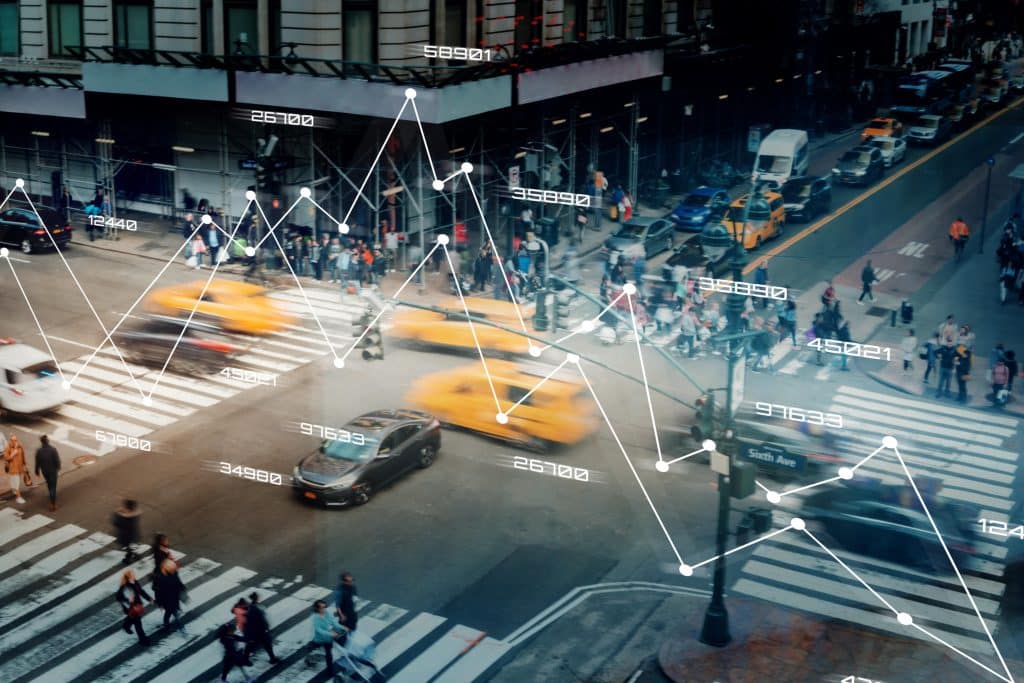AI-powered smart cities are no longer a futuristic concept—they’re unfolding right now, reshaping urban life. From cities using Generative AI to model heat risk per building, to master-planned developments that embed intelligence from the start, the smart city landscape is evolving fast. In this article, we’ll explore how cities are strategically deploying GenAI, adopting human-centric embedded design, and tackling real-world challenges in service of smarter, more resilient urban environments.

1. The Rise of AI-Powered Smart Cities: A Strategic Shift
Cities globally are accelerating toward becoming AI-powered smart cities, leveraging artificial intelligence not merely as an add-on but as a core driver of urban transformation. Reports from major consultancies and research collaborations show that over half of surveyed cities already use AI, with adoption projected to exceed 80% within the next few years.
Key AI capabilities now shaping smart city functions include:
- Machine learning for predictive analytics
- Robotic process automation (RPA) for handling routine workflows
- Generative AI (GenAI) for simulation, content creation, and natural language interfaces
- Agentic AI, which autonomously acts on insights without direct human input
Melbourne provides a striking example, where AI integrates with IoT and 5G for real-time water management, forecasting recycled water quality, and monitoring illegal waste dumping.
Implementing AI effectively requires leadership, modern infrastructure, cross-sector collaboration, and strong governance frameworks. Cities that combine these elements with strategic vision are leading the AI-powered smart cities movement.
2. Generative AI Meets Urban Resilience & Inclusion
While AI-powered systems are evolving, GenAI offers a novel leap—equipping smart cities with conversational interfaces, simulation tools, and tailored feedback loops. Studies show that GenAI built on IoT data and digital twins enhances urban management by interacting intuitively with citizens, operators, and planners.
Imagine a GenAI assistant that:
- Provides a city planner with a quick analysis of neighborhoods facing the highest heat risk tomorrow
- Advises a resident on safe walking routes during extreme heat events
- Offers operators real-time AI-generated scenarios to dispatch cooling resources
GenAI’s strength lies in its ability to process multimodal content, generate simulations, and translate complex urban data into intuitive conversations. This makes cities more inclusive and accessible to diverse users.
3. A Smart Indian Example: AI and Satellites Mapping Heat Risk
In India, where cities regularly endure lethal heatwaves, GenAI and satellite data are being deployed to map heat vulnerability down to individual buildings. Nonprofits like SEEDS and Chintan use AI models that analyze building materials, land use, and temperatures to pinpoint where heat risk is most severe—particularly in low-income neighborhoods.
These granular models support ward-level heat action planning. However, gaps remain—few Indian states legally categorize heat waves as disasters, and limitations in funding and governance slow comprehensive implementation.
Still, this case highlights a powerful trend: AI-powered smart cities using high-resolution data to protect vulnerable populations, blending technology with equity-driven planning.
4. Embedded Intelligence: Designing Smart from the Ground Up
A growing trend within AI-powered smart cities is embedded intelligence—integrating smart systems into urban design from inception, not retroactively.
Examples include:
- In Australia’s Point Estate, over two-thirds of the site preserves natural ecosystems, while digital tools optimize construction and reduce environmental impact.
- At Singapore’s National University, a centralized Integrated Operations Center monitors campus security, infrastructure, and systems in real time, enhancing responsiveness and sustainability.
- In Saudi Arabia’s Sudair City, planners embed zoning, infrastructure timing, and services into a phased development, aligning industrial and residential growth in a smart, scalable design.
Across these examples, smart cities are less about gadgets and more about systems-thinking, ensuring that design, data, and delivery work in sync for human resilience and efficiency.
5. Balancing Tech with Ethics and Human-Centered Design
As cities evolve into complex AI ecosystems, ethical considerations must not be overlooked. Researchers have proposed frameworks for evaluating smart city applications using rights-based principles to detect and prevent unethical outcomes.
This ethical guardrail is vital when AI systems influence public services, security, and personal data. Combined with the movement toward human-centric embedded design, it ensures that technology serves people—not the other way around.
6. Why AI-Powered Smart Cities Matter Now
AI-powered smart cities offer us:
- Granular risk reduction—as with heat mapping in India
- Integrated, rooted intelligence—embedded during urban planning, not added later
- Inclusive interaction—via GenAI that adapts to user needs
- Ethical accountability—through frameworks that protect citizens
The smart city market continues to grow rapidly, with projections showing expansion from nearly 800 billion dollars in 2024 to more than 940 billion dollars in 2025, and nearly doubling again by 2029. Other forecasts estimate growth to 1.45 trillion dollars by 2030.
And AI-powered solutions—especially when embedded thoughtfully—are central to that growth.
7. What Cities Can Do: A Bold but Practical Roadmap
A. Develop a Strategic AI Vision
- Use GenAI tools to surface citizen needs and provide decision support
- Engage community voices to co-create smart systems
B. Build the Foundation: Modern Infrastructure
- Invest in IoT networks, edge computing, digital twins, and 5G/6G
- Build open platforms and APIs for interoperability and resilience
C. Embed Intelligence Early
- Collaborate with planners and architects to make smartness a built-in feature
- Use digital twins and simulation tools to test livability, energy, and climate responses before construction
D. Apply Ethical Oversight
- Adopt ethical frameworks to assess smart systems
- Ensure transparency, privacy safeguards, and bias mitigation
E. Use GenAI for Real-Time City Services
- Deploy conversational agents for citizen services, from healthcare to transit
- Simulate future scenarios (e.g., extreme weather, mass events) for proactive planning
F. Prioritize Equity & Heat Resilience
- Use high-resolution mapping for heat, flood, or air-quality risks
- Target vulnerable neighborhoods with infrastructure upgrades such as cooling stations and green roofs
G. Build Partnerships
- Foster public-private-nonprofit collaboration to fund and sustain smart city projects
- Combine innovation with accountability and social value
Conclusion: The Future Is Now—and Smarter
AI-powered smart cities aren’t science fiction—they are here. From GenAI interfaces and real-time heat mapping in India, to master-planned communities in Australia and Saudi Arabia, cities are becoming more resilient, inclusive, and capable of anticipating the future.
The recipe combines high-resolution data, embedded design, ethical governance, and human-centered GenAI tools. Whether you’re a city planner, technologist, policymaker, or community advocate, the time to act is now—to build cities that are not just smart but sustainable, equitable, and truly alive for the people who inhabit them.
References
- Deloitte, ServiceNow, Nvidia, & ThoughtLab. (2025). How to build AI-powered cities intelligently. Available at: https://www.theaustralian.com.au (Accessed: 20 August 2025).
- Wired. (2025). India is using AI and satellites to map urban heat vulnerability down to the building level. Available at: https://www.wired.com (Accessed: 20 August 2025).
- MarketsandMarkets. (2024). Smart cities market by focus area and region – Global forecast to 2030. Available at: https://www.marketsandmarkets.com (Accessed: 20 August 2025).









